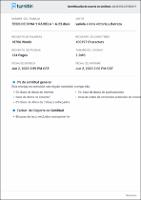Patrones familiares y sociales que intervienen en el comportamiento antisocial de los privados de libertad de 18 a 25 años del centro penitenciario de Bocas del Toro.
Fecha
2023Autor
Barraza Canto, Irina
Victoria, Yariela
Metadatos
Mostrar el registro completo del ítemResumen
La presente investigación parte del supuesto de que los patrones familiares y sociales intervienen
en el comportamiento antisocial de los privados de libertad de 18 a 25 años y plantea como objetivo
general, analizar los patrones familiares y sociales intervinientes en el comportamiento antisocial de
los privados de libertad de 18 a 25 años del Centro Penitenciario de Bocas del Toro.
Se utilizó la metodología mixta, con un alcance exploratorio, descriptivo y correlacional para la parte
cuantitativa y diseño fenomenológico para la cualitativa. Se manejó la muestra probabilística
aleatoria simple y por conveniencia.
La información se recopiló a través de cuestionario con la técnica encuesta para los datos
cuantitativos, para la información cualitativa se utilizó una guía de preguntas y la técnica entrevistas.
Los datos cuantitativos se analizaron mediante los SPAS y para los cualitativos, a través de mapas
conceptuales. Los principales resultados revelan que los patrones familiares influyen más que los
patrones sociales en el comportamiento antisocial de los privados de libertad, probando, de esta
manera, la hipótesis de la investigación. This research is based on the assumption that family and social patterns intervene in the antisocial
behavior of inmates between 18 and 25 years of age, and its general objective is to analyze the family
and social patterns that intervene in the antisocial behavior of inmates between 18 and 25 years of
age in the Bocas del Toro Penitentiary Center. A mixed methodology was used, with an exploratory,
descriptive, and correlational scope for the quantitative part and a phenomenological design for the
qualitative part. A simple random probability sample by convenience was used. The information was
collected through a questionnaire using the survey technique for the quantitative data, and for the
qualitative information a questionnaire guide and the semi-structured interview technique were used.
Quantitative data were analyzed using SPSS and qualitative data were analyzed using concept maps.
The main results reveal that family patterns influence more than social patterns in the antisocial
behavior of the inmates, thus proving the hypothesis of the research. This research is based on the assumption that family and social patterns intervene in the antisocial
behavior of inmates between 18 and 25 years of age, and its general objective is to analyze the family
and social patterns that intervene in the antisocial behavior of inmates between 18 and 25 years of
age in the Bocas del Toro Penitentiary Center. A mixed methodology was used, with an exploratory,
descriptive, and correlational scope for the quantitative part and a phenomenological design for the
qualitative part. A simple random probability sample by convenience was used. The information was
collected through a questionnaire using the survey technique for the quantitative data, and for the
qualitative information a questionnaire guide and the semi-structured interview technique were used.
Quantitative data were analyzed using SPSS and qualitative data were analyzed using concept maps.
The main results reveal that family patterns influence more than social patterns in the antisocial
behavior of the inmates, thus proving the hypothesis of the research.

